2015 RANGE ROVER SPORT QUICK TAKES
2015 RANGE ROVER SPORT QUICK TAKES
- New Range Rover Sport SVR introduced with a 550hp supercharged V8 engine, specially tuned four-wheel drive chassis and exclusive design details
- Optional Driver Assistance Pack includes Traffic Sign Recognition, Lane Departure Warning, Parallel Park, Park Exit, Perpendicular Park and 360-degree Park Distance Control3
- Land Rover InControl® Apps available as a standalone option or in conjunction with the Meridian™ audio options
- Revised Climate Comfort and Visibility Packages add Blind Spot Monitoring with Closing Vehicle Sensing and Reverse Traffic Detection3
- SiriusXM® Satellite Radio and HD Radio™ standard on SE, HSE and Supercharged
- Approach lamps redesigned: puddle lamps now project vehicle silhouette instead of vehicle name
At-A-Glance:
- Second-generation of this performance-tuned luxury SUV
- High strength aluminum structure provides a weight savings of approximately 800lbs. over the previous generation Range Rover Sport for exceptional agility and performance with improved fuel economy
- 5+2 third row seating option for occasional use
- Choice of 340hp supercharged V6 or 510hp supercharged V8 engine (550hp for SVR)
- Standard eight speed automatic transmission
- Choice of 4WD transfer cases – single speed Torsen or two-speed locking with low range
- Advanced electronic driver assistance technologies
- Superbly crafted, luxurious interior
- Standard Intelligent Stop/Start technology to improve fuel economy and reduce emissions
- Available fully automatic Terrain Response® 2 system3
- Exceptional on-road dynamics and all-terrain performance
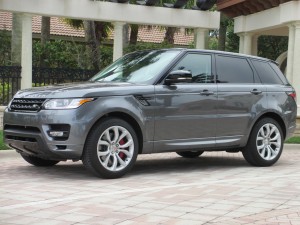 The new-generation Range Rover Sport, which already established its performance credentials by setting a record for SUVs climbing Pikes Peak (12 min, 35.61 sec.), generates even more excitement for 2015 with the introduction of the ultra-performance Range Rover Sport SVR model.
The new-generation Range Rover Sport, which already established its performance credentials by setting a record for SUVs climbing Pikes Peak (12 min, 35.61 sec.), generates even more excitement for 2015 with the introduction of the ultra-performance Range Rover Sport SVR model.
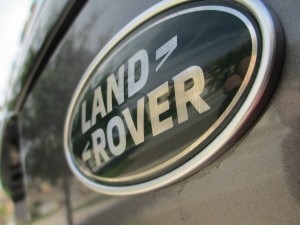 Created by the Jaguar Land Rover Special Vehicle Operations team, the 2015 Range Rover Sport SVR is the highest-performance Land Rover vehicle ever, capable of accelerating from 0-60 mph in 4.5 seconds and achieving an electronically limited top track speed of 162 mph2. The SVO team also specially tuned the ZF® 8HP70 eight-speed automatic transmission and four-wheel drive chassis to give the Range Rover Sport SVR exceptional agility while also preserving all-terrain capability.
Created by the Jaguar Land Rover Special Vehicle Operations team, the 2015 Range Rover Sport SVR is the highest-performance Land Rover vehicle ever, capable of accelerating from 0-60 mph in 4.5 seconds and achieving an electronically limited top track speed of 162 mph2. The SVO team also specially tuned the ZF® 8HP70 eight-speed automatic transmission and four-wheel drive chassis to give the Range Rover Sport SVR exceptional agility while also preserving all-terrain capability.
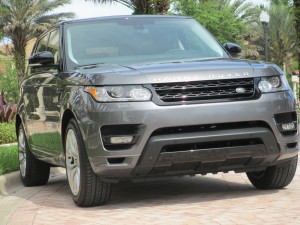 Developed alongside the new-generation Range Rover, the Range Rover Sport delivers exceptional on-road dynamics with genuine Land Rover all-terrain capability. The Range Rover Sport presents an assertive and muscular exterior, luxurious interior, and the practical flexibility provided by the option of 5+2 third row seating for occasional use.
Developed alongside the new-generation Range Rover, the Range Rover Sport delivers exceptional on-road dynamics with genuine Land Rover all-terrain capability. The Range Rover Sport presents an assertive and muscular exterior, luxurious interior, and the practical flexibility provided by the option of 5+2 third row seating for occasional use.
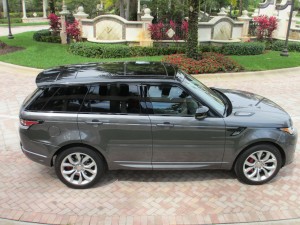 Featuring Land Rover advanced air suspension and innovative dynamic chassis technologies, the Range Rover Sport features an aluminum unibody architecture to achieve a weight savings of approximately 800lbs. (Note to editor: The previous generation vehicle featured an “Integrated body-frame,” which was composed of a steel unibody mounted on a full frame chassis). The weight reduction transforms the vehicle’s dynamic performance, enabling it to blend agile handling with exceptional comfort and to offer a unique mix of sporting luxury and a dynamic, engaging driving experience.
Featuring Land Rover advanced air suspension and innovative dynamic chassis technologies, the Range Rover Sport features an aluminum unibody architecture to achieve a weight savings of approximately 800lbs. (Note to editor: The previous generation vehicle featured an “Integrated body-frame,” which was composed of a steel unibody mounted on a full frame chassis). The weight reduction transforms the vehicle’s dynamic performance, enabling it to blend agile handling with exceptional comfort and to offer a unique mix of sporting luxury and a dynamic, engaging driving experience.
RANGE ROVER SPORT SVR; FASTEST LAND ROVER VEHICLE EVER
The new Range Rover Sport SVR is powered by a 5.0-liter supercharged V8 engine tuned to produce 550hp and 502lb-ft of torque – increases of 40hp and 41lb-ft over the supercharged V8 in the Range Rover Sport Supercharged model. An electronically controlled two-stage active exhaust gives the Range Rover Sport SVR an inspired soundtrack to accompany the astonishing performance at higher engine speeds while maintaining refinement during everyday driving.
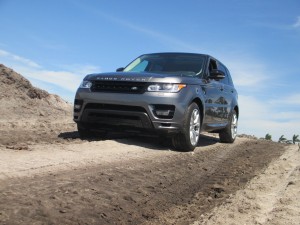 Emphasizing all-terrain capability, vehicles are equipped with 21-inch alloy wheels with 275/45 R21 all-season tires. The exterior design of the SVR makes a powerful visual impact while also enhancing cooling and aerodynamic efficiencies.
Emphasizing all-terrain capability, vehicles are equipped with 21-inch alloy wheels with 275/45 R21 all-season tires. The exterior design of the SVR makes a powerful visual impact while also enhancing cooling and aerodynamic efficiencies.
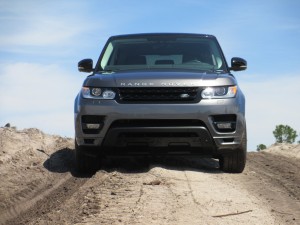 Design enhancements include larger air intakes in the front bumper to increase airflow to two intercoolers that reduce the temperature of pressurized air from the supercharger before it enters the engine.
Design enhancements include larger air intakes in the front bumper to increase airflow to two intercoolers that reduce the temperature of pressurized air from the supercharger before it enters the engine.
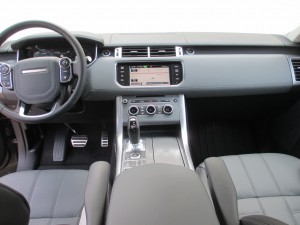 A modified interior featuring sport seats provides visual differentiation and offers increased support during spirited driving. The SVR was subject to exhaustive testing, with prototype vehicles completing nearly 1,000 laps around Germany’s NürburgringNordschleife circuit; its best lap was just 8 minutes 14 seconds.
A modified interior featuring sport seats provides visual differentiation and offers increased support during spirited driving. The SVR was subject to exhaustive testing, with prototype vehicles completing nearly 1,000 laps around Germany’s NürburgringNordschleife circuit; its best lap was just 8 minutes 14 seconds.
SVR enhanced driveline
With the standard four-wheel-drive system, the eight-speed transmission receives additional torque in its lower gears. In Dynamic mode, sport-driving characteristics are intensified thanks to sharper throttle response and more incisive gearshift logic. Shift times have been reduced by up to 50 percent compared to the Range Rover Sport Supercharged.
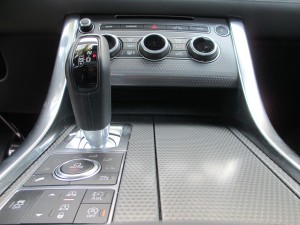 The transmission’s adaptive shift strategy monitors acceleration and brake inputs, lateral cornering forces, kickdown requests and even the slope of gradients, before choosing one of 25 pre-determined programs to seamlessly adapt to driver behavior and road conditions. Sportier driving triggers more aggressive gearshifts and delays upshifts.
The transmission’s adaptive shift strategy monitors acceleration and brake inputs, lateral cornering forces, kickdown requests and even the slope of gradients, before choosing one of 25 pre-determined programs to seamlessly adapt to driver behavior and road conditions. Sportier driving triggers more aggressive gearshifts and delays upshifts.
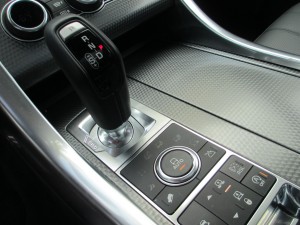 To improve dynamic stability, the throttle is automatically blipped during high-speed downshifts, smoothing the transition between ratios. This function also allows the transmission to perform a series of rapid downshifts under hard braking with maximum refinement and control. Corner Recognition maintains one gear through a turn to improve stability while also ensuring a quick response for exiting the curve3. Similarly, the transmission recognizes a series of overtaking maneuvers and maintains a lower gear to ensure instant acceleration2.
To improve dynamic stability, the throttle is automatically blipped during high-speed downshifts, smoothing the transition between ratios. This function also allows the transmission to perform a series of rapid downshifts under hard braking with maximum refinement and control. Corner Recognition maintains one gear through a turn to improve stability while also ensuring a quick response for exiting the curve3. Similarly, the transmission recognizes a series of overtaking maneuvers and maintains a lower gear to ensure instant acceleration2.
In manual mode, gearshifts are made via the paddle shift controls or the gear lever. Even with this performance focus, there is no negative impact on refinement: the transmission’s torque converter operates for smooth take off in first gear, but is bypassed by a locking clutch from second gear upward, creating a direct link between the transmission and the driven wheels.
Full capability maintained
The Range Rover Sport SVR mirrors the wide breadth of capability found in the Range Rover Sport Supercharged model. Standard equipment includes permanent four-wheel drive with a 50:50 torque split and a two-speed transfer case. The electronically controlled multi-plate clutch in the center differential distributes torque between the front and rear axles; up to 100 percent can be channeled to either axle in extreme conditions. An electronic traction-control system further contributes to capability. The transfer case offers selectable low- and high-range, with shift on the move capability at up to 37 mph. Low-range ratio is 2.93:1, providing an extremely low crawl speed for off-road terrain.
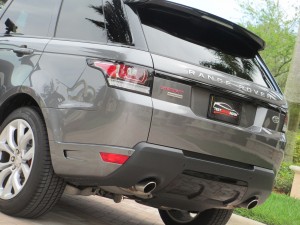 The Dynamic Active Rear Locking Differential has been recalibrated for the SVR. The differential now locks earlier and to an increased extent, satisfying performance-minded drivers and ensuring torque is transferred to the rear wheel with most traction, increasing agility3.
The Dynamic Active Rear Locking Differential has been recalibrated for the SVR. The differential now locks earlier and to an increased extent, satisfying performance-minded drivers and ensuring torque is transferred to the rear wheel with most traction, increasing agility3.
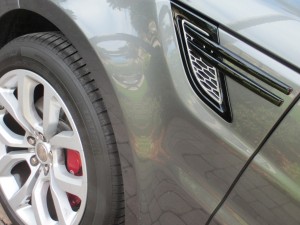 Torque Vectoring is also uniquely recalibrated for the SVR. It uses the vehicle’s brake system to create the effect of a torque-vectoring differential, constantly balancing the distribution of engine torque between the four wheels during cornering, for improved grip and steering, and reduced understeer3.
Torque Vectoring is also uniquely recalibrated for the SVR. It uses the vehicle’s brake system to create the effect of a torque-vectoring differential, constantly balancing the distribution of engine torque between the four wheels during cornering, for improved grip and steering, and reduced understeer3.
SVR exclusive design
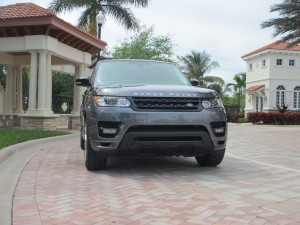 Designed by the Jaguar Land Rover Special Vehicle Operations (SVO) team, the Range Rover Sport SVR makes a strong visual statement. The front bumper features muscular trapezoidal air intakes to provide additional airflow for the intercoolers that channel air to the 550hp supercharged engine. The deeper front bumper’s more aggressive lower section can also be removed if necessary for extreme off-roading. The air intakes also provide additional cooling for the six-piston Brembo brakes.
Designed by the Jaguar Land Rover Special Vehicle Operations (SVO) team, the Range Rover Sport SVR makes a strong visual statement. The front bumper features muscular trapezoidal air intakes to provide additional airflow for the intercoolers that channel air to the 550hp supercharged engine. The deeper front bumper’s more aggressive lower section can also be removed if necessary for extreme off-roading. The air intakes also provide additional cooling for the six-piston Brembo brakes.
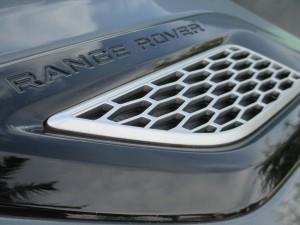 Additional SVR-exclusive elements include dark Range Rover script on the clamshell hood, which features revised vents, and a new grille in a dark finish that contrasts with the headlights’ LED signature lighting. An all-new fender design incorporates a distinctively designed vent, while unique side moldings add muscularity.
Additional SVR-exclusive elements include dark Range Rover script on the clamshell hood, which features revised vents, and a new grille in a dark finish that contrasts with the headlights’ LED signature lighting. An all-new fender design incorporates a distinctively designed vent, while unique side moldings add muscularity.
At the rear, prominent Range Rover Sport SVR badging and a pronounced high-mounted spoiler reduces lift. The unique rear bumper features a gloss black diffuser, which incorporates quad exhaust pipes. The new rear spoiler reduces lift, and has been carefully balanced with the new front bumper. A new NVH comb mounted beneath the front bumper reduces wind noise and improves aerodynamic efficiency, reducing front-end lift. Exterior trim detailed in black and headlights with black casings round off the design enhancements, creating a visually imposing road presence.
SVR interior treatment
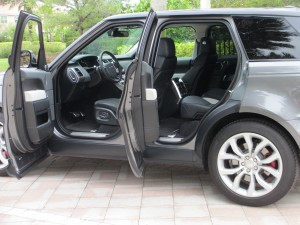 Inside the Range Rover Sport SVR, 14-way power leather sports seats offer additional lateral support during spirited driving. The rear seats have been redesigned to echo the performance-oriented front seats. The result is a sporty four-seat look, with space for an occasional fifth passenger.
Inside the Range Rover Sport SVR, 14-way power leather sports seats offer additional lateral support during spirited driving. The rear seats have been redesigned to echo the performance-oriented front seats. The result is a sporty four-seat look, with space for an occasional fifth passenger.
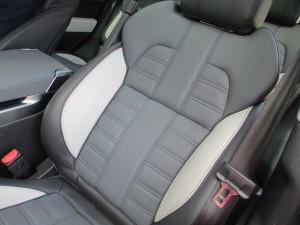 The seats are finished in luxurious Oxford leather with ribbed, quilted centers, Ebony Black top stitching, eye-catching reflective piping, and all feature the Range Rover Sport SVR logo. Four striking interior color options are available: Ebony Black; Ebony Black and Cirrus White; Ebony Black and Pimento Red; Ebony Black and Tan. Turned aluminum interior trim details are standard, with optional carbon fiber trim available for the door panels, center console, dashboard and steering-wheel bezel available.
The seats are finished in luxurious Oxford leather with ribbed, quilted centers, Ebony Black top stitching, eye-catching reflective piping, and all feature the Range Rover Sport SVR logo. Four striking interior color options are available: Ebony Black; Ebony Black and Cirrus White; Ebony Black and Pimento Red; Ebony Black and Tan. Turned aluminum interior trim details are standard, with optional carbon fiber trim available for the door panels, center console, dashboard and steering-wheel bezel available.
Exhilarating SVR soundtrack
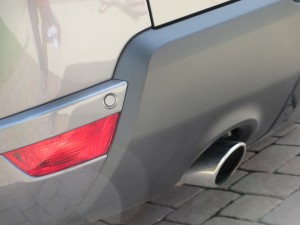 An exclusive two-stage active exhaust uses electronically controlled valves to deliver a rousing exhaust sound. The system features larger diameter pipes – up from 2.2-inches (55mm) in the Supercharged V8 to 2.4-inches (60mm). At lower engine speeds, electronically controlled valves close off two of the four tailpipes. As engine speed and load increases – typically around 3,000 rpm – the valves open, allowing greater flow through all four tailpipes and producing a stirring staccato exhaust note at higher engine speeds. Together with modified engine tuning that cuts the air charge far more quickly when the driver lifts off the throttle, the new exhaust also creates a pronounced crackle during deceleration. The driver can also select a quiet mode. In addition, a symposer enriches sound quality by filtering desirable induction noise into the cabin.
An exclusive two-stage active exhaust uses electronically controlled valves to deliver a rousing exhaust sound. The system features larger diameter pipes – up from 2.2-inches (55mm) in the Supercharged V8 to 2.4-inches (60mm). At lower engine speeds, electronically controlled valves close off two of the four tailpipes. As engine speed and load increases – typically around 3,000 rpm – the valves open, allowing greater flow through all four tailpipes and producing a stirring staccato exhaust note at higher engine speeds. Together with modified engine tuning that cuts the air charge far more quickly when the driver lifts off the throttle, the new exhaust also creates a pronounced crackle during deceleration. The driver can also select a quiet mode. In addition, a symposer enriches sound quality by filtering desirable induction noise into the cabin.
Enhanced suspension and steering
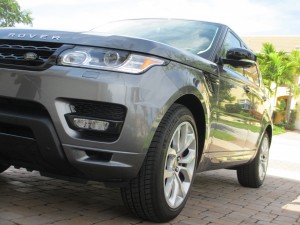 For sportier handling and composure, the Range Rover Sport uses an exclusively tuned version of the cross-linked, four-wheel air suspension of the standard model. Adaptive Dynamics with continuously variable magnetorheological dampers adjust the damping force almost instantaneously in response to changing road-surface conditions and driver inputs3. Rear suspension subframe bushings, stiffened by 20 percent over the Range Rover Sport Supercharged, ensuring even quicker response to driver inputs.
For sportier handling and composure, the Range Rover Sport uses an exclusively tuned version of the cross-linked, four-wheel air suspension of the standard model. Adaptive Dynamics with continuously variable magnetorheological dampers adjust the damping force almost instantaneously in response to changing road-surface conditions and driver inputs3. Rear suspension subframe bushings, stiffened by 20 percent over the Range Rover Sport Supercharged, ensuring even quicker response to driver inputs.
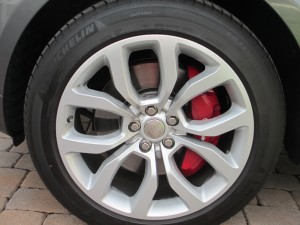 While offering a level of performance normally associated with performance cars, the vehicle’s high levels of comfort and off-road capability have not been sacrificed: the ride quality retains its compliance and the ride height is unaltered, with an adjustable range from 2 inches (50mm) in access mode up to 9.3-inches (235mm) for off-roading. Wheel travel also remains identical, with 10.2-inches of movement at the front and 10.7-inches (272mm) at the rear. Wading depth remains 33.5-inches (850mm)3. Six Terrain Response® 2 settings continue to be available: General, Dynamic, Grass/Gravel/Snow, Mud/Ruts, Sand, and Rock Crawl. Alternatively, the “Auto” setting intelligently selects the most appropriate mode3.
While offering a level of performance normally associated with performance cars, the vehicle’s high levels of comfort and off-road capability have not been sacrificed: the ride quality retains its compliance and the ride height is unaltered, with an adjustable range from 2 inches (50mm) in access mode up to 9.3-inches (235mm) for off-roading. Wheel travel also remains identical, with 10.2-inches of movement at the front and 10.7-inches (272mm) at the rear. Wading depth remains 33.5-inches (850mm)3. Six Terrain Response® 2 settings continue to be available: General, Dynamic, Grass/Gravel/Snow, Mud/Ruts, Sand, and Rock Crawl. Alternatively, the “Auto” setting intelligently selects the most appropriate mode3.
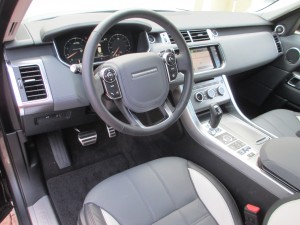 The revised Electric Power-Assisted Steering (EPAS) system features variable-ratio, speed-sensitive assistance, with added weighting for a more immediate and connected feel at speed2. Range Rover Sport SVR-specific 21-inch alloy wheels carry all-season 275/45 R21 tires.
The revised Electric Power-Assisted Steering (EPAS) system features variable-ratio, speed-sensitive assistance, with added weighting for a more immediate and connected feel at speed2. Range Rover Sport SVR-specific 21-inch alloy wheels carry all-season 275/45 R21 tires.
Active-Roll Control tuned for flatter, faster cornering
Working in conjunction with air springs and Active Dynamics continuously variable dampers, the two-channel Active-Roll Control (ARC) enhances high-performance capability. Replacing traditional anti-roll bars, ARC employs actuators powered by a hydraulic pump to keep body roll in check, adapting to body accelerations up to 1,000 times a second3. Compared with earlier iterations with a single actuator, ARC uses two actuators to respond independently to lateral roll at each axle, providing greater precision. When ARC senses vehicle roll, it is designed to apply an opposing torque, keeping the body level and composed. ARC allows the Range Rover Sport SVR to corner flatter and faster. Dynamic mode further reduces body roll for maximum handling capability3.
While ARC is tuned to behave uniquely for the Range Rover Sport SVR during performance driving, it uses the same software map as other Range Rover Sport models when off-road use is detected by on-board sensors.
RANGE ROVER SPORT DESIGN
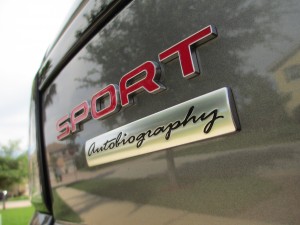 The new-generation Range Rover Sport captures the distinctive DNA of its predecessor, but with a bold evolution that places it between the flagship Range Rover and the Range Rover Evoque models.
The new-generation Range Rover Sport captures the distinctive DNA of its predecessor, but with a bold evolution that places it between the flagship Range Rover and the Range Rover Evoque models.
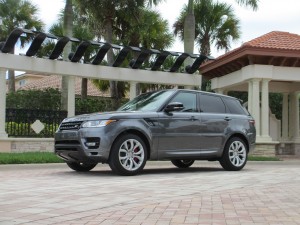 At 191-inches, the Range Rover Sport offers outstanding maneuverability and ease of parking. Compared to the previous-generation model, a wheelbase that’s longer by 7-inches yields greater room and improved access for rear passengers. The Range Rover Sport is 6.0-inches shorter and 2.1-inches lower than the Range Rover on which it is based and weighs about 100lbs. less when similarly equipped.
At 191-inches, the Range Rover Sport offers outstanding maneuverability and ease of parking. Compared to the previous-generation model, a wheelbase that’s longer by 7-inches yields greater room and improved access for rear passengers. The Range Rover Sport is 6.0-inches shorter and 2.1-inches lower than the Range Rover on which it is based and weighs about 100lbs. less when similarly equipped.
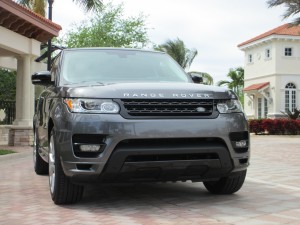 The front end sports a modern, streamlined appearance, with slim signature LED headlights, rearward sloping grille and sculpted corners. New interpretations of classic Range Rover Sport design cues include the signature clamshell hood, floating roof, side fender vents, and bolder versions of the powerful wheel arch design, horizontal body feature lines and distinctive rocker moldings.
The front end sports a modern, streamlined appearance, with slim signature LED headlights, rearward sloping grille and sculpted corners. New interpretations of classic Range Rover Sport design cues include the signature clamshell hood, floating roof, side fender vents, and bolder versions of the powerful wheel arch design, horizontal body feature lines and distinctive rocker moldings.
Finely crafted details
 The side fender vents have a dynamic, sloping treatment and are matched by twin vents in the hood. The established Range Rover Sport two-bar theme is reflected in the twin strakes on the fender vents, the two-bar front grille and the twin lines in the tail lamp designs.
The side fender vents have a dynamic, sloping treatment and are matched by twin vents in the hood. The established Range Rover Sport two-bar theme is reflected in the twin strakes on the fender vents, the two-bar front grille and the twin lines in the tail lamp designs.
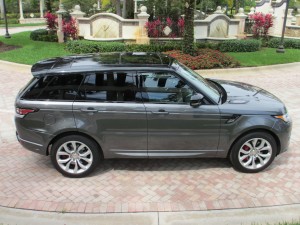 Near-flush side glass and a premium gloss black finish on the pillars accentuate the Range Rover floating roof design – which can be highlighted with contrast roof colors – while also emphasizing the streamlined body. Brembo brake calipers finished in red, and a Black Package, which removes all brightwork from the exterior, are also available.
Near-flush side glass and a premium gloss black finish on the pillars accentuate the Range Rover floating roof design – which can be highlighted with contrast roof colors – while also emphasizing the streamlined body. Brembo brake calipers finished in red, and a Black Package, which removes all brightwork from the exterior, are also available.
At the front, the large outboard air intakes and bold trapezoidal shapes housing the central bumper beam and skid plate convey high-performance and high-capability. At the rear, a skid plate flanked by large twin exhaust outlets repeats the trapezoidal theme.
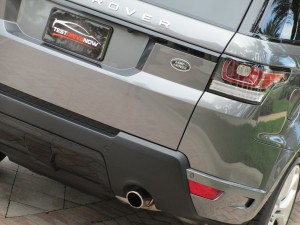 Rear lamp clusters also use LED technology. The main tail and stop lamps echo the headlamps’ distinctive design. Both front and rear lamps flow round into the shoulders of the body with the distinctive tapering blade design featured on the other Range Rover vehicles.
Rear lamp clusters also use LED technology. The main tail and stop lamps echo the headlamps’ distinctive design. Both front and rear lamps flow round into the shoulders of the body with the distinctive tapering blade design featured on the other Range Rover vehicles.
Luxurious interior with a strong sporting character
The cabin’s strong, architectural forms are enhanced by a clean surface treatment and premium materials. The cockpit’s dynamic character is enhanced by the fast angle of the center stack. Its satin chrome pillars flow from the instrument panel into the rear cabin, and the aluminum accents flow from the center console into the dashboard fascia.
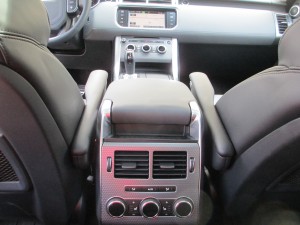 The center console positions the controls close to the driver and creates a cosseting feel for the front occupants. The small-diameter, thick-rimmed steering wheel, vertical gear shifter and seats with generous side bolsters support the sporting ambience. The front and rear seats feature a sculpted design with enhanced padding to the front. The available third row is designed for occasional use, and power-folds flat into the floor to preserve cargo versatility.
The center console positions the controls close to the driver and creates a cosseting feel for the front occupants. The small-diameter, thick-rimmed steering wheel, vertical gear shifter and seats with generous side bolsters support the sporting ambience. The front and rear seats feature a sculpted design with enhanced padding to the front. The available third row is designed for occasional use, and power-folds flat into the floor to preserve cargo versatility.
Premium materials, superior craftsmanship
The Range Rover Sport is crafted using the highest quality materials, with specially selected colors and textures to enhance the model’s unique blend of luxury with a distinctive sporting character. Modern finishes and veneers give the cabin a dynamic and contemporary feel.
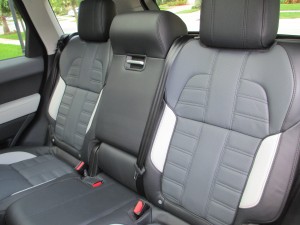 Soft-touch surfaces are used for key touch points around the cabin, such as the dashboard fascia mid-section. Genuine metal details include the choice of distinctive aluminum finishes on the center console, fascia caps and door trim.
Soft-touch surfaces are used for key touch points around the cabin, such as the dashboard fascia mid-section. Genuine metal details include the choice of distinctive aluminum finishes on the center console, fascia caps and door trim.
The focus on quality and traditional craftsmanship can be seen in the beautifully tailored twin-needle stitching used to finish the leather seats and leather-wrapped interior surfaces. Range Rover designers specify all aspects of the stitching, from the length and direction of the stitches, to the spin, thickness, and material of the thread, and even the size and shape of the needle.
Individual choice for discerning customers
For maximum personalization, an expansive choice of special features includes color-themed interiors with multi-toned designs and a range of alloy wheels from 19-22-inches.
Autobiography models and Supercharged models with the optional ‘Dynamic’ pack, unlock exclusive trim options and performance features, among these a gloss black grille and exterior details, body-colored lower bumpers and side sills, unique interior color themes and finishes, plus an increased top track speed of 155 mph (250km/h) 2 for the supercharged 5-liter, special 21- or 22-inch alloy wheels, and red Brembo brake calipers.
The full range of design options available include:
- 9 interior color themes, plus additional choice of seat color
- 4 aluminum interior finishes, 2 real wood veneers
- 3 headliner colors
- 16 exterior paint finishes
- 3 contrast roof colors – Corris Grey, Santorini Black or Indus Silver
- Wheel options ranging from 19-22 inches
- Atlas Silver, Dark Atlas or Gloss Black finish for the exterior accents
DYNAMIC CAPABILITY
The stiff and light aluminum structure is supported by front and rear suspension systems designed to deliver a broad range of dynamic capabilities across all types of terrain. Air suspension, and the latest chassis and stability technologies – including upgraded Dynamic Response and Adaptive Dynamics systems – also contribute to the vehicle’s enhanced capability3. On-road dynamics are characterized by direct steering, with increased handling agility and reduced body roll delivering flatter, more confident cornering.
Air suspension
Underpinning the enhanced driving capability of the new-generation Range Rover Sport is a fully independent aluminum suspension that is double isolated, with wide-spaced double-wishbones at the front and a multi-link layout at the rear. The system delivers impressive wheel travel – with 10.2-inches (260mm) of front travel and 10.7-inches (272mm) at the rear. With 21.5-inches (546mm) of articulation, the suspension delivers the composure to deal with the toughest conditions.
The high strength aluminum chassis architecture is combined with a next-generation four-corner air suspension to maximize the vehicle’s versatility both on- and off-road. This suspension offers variable ride height with two off-road lift settings: 1.4-inches lift for standard use and a 2.6-inches lift for more severe off-road use.
The maximum ground clearance is available up to 31 mph (50 km/h). The system provides up to 4.5-inches (115mm) of regular movement, from the lowest setting ‘access height’ (1.9-inches / 50mm lowering for easier entry and exit) to the standard off-road height. An automatic extension is triggered when on-board sensors determine additional 1.4-inch of lift is needed, and an additional manually selected extension of 1.4-inch can give a total adjustable height range of about 7-inches (185mm).
Advanced technologies enhance dynamics
A key element of the vehicle’s agile and engaging character is the Electric Power Assisted Steering (EPAS) system featuring variable-ratio speed-sensitive assistance. Geared for 3.0 turns lock-to-lock, the system provides a quick overall steering ratio, but is slower just around the on-center position for enhanced stability and control at speed.
Advanced chassis and vehicle technologies enhance suspension performance. Supercharged V8 models are equipped with a dedicated Dynamic mode in the Terrain Response® 2 system3, providing a more sporting bias during enthusiastic on-road driving, with a firmer ride, tighter body control, reduced roll and more responsive steering and performance. Dynamic mode activates performance calibrations for a wide range of vehicle and chassis systems including the electric power steering, throttle and transmission responses, damping and lean control, and settings for the traction and stability systems.
For the ultimate sporting driving experience, Dynamic mode is specified in combination with a number of key technologies, including Dynamic Response active lean control, a Dynamic Active Rear Locking Differential, and Torque Vectoring by Braking. Significantly reducing the amount of body lean during cornering, Dynamic Response transforms vehicle handling and occupant comfort3. This two-channel active lean control system is capable of controlling the front and rear suspension independently. This allows it to be tuned to deliver increased low-speed agility, along with enhanced control and stability at high speed.
The Dynamic Active Rear Locking Differential employs an electronically controlled differential that can vary the degree of lock-up almost instantaneously to further maximize traction, handling and cornering stability3.
Torque Vectoring by Braking uses the vehicle’s brake system to generate the effect of a torque vectoring differential. This feature constantly balances the distribution of engine torque among the four wheels during cornering, resulting in improved grip and steering, and a reduced level of understeer3.
The system uses the Dynamic Stability Control (DSC) module and monitors the vehicle 100 times per second. As the Range Rover Sport accelerates through a corner, the system uses yaw sensors to detect the onset of understeer. To reduce understeer, imperceptible levels of braking are used to correct the vehicle attitude, while engine torque is transferred to the outside wheels, which have more grip, thus maintaining traction and steering control3.
Supercharged V8 models are also equipped with Adaptive Dynamics, featuring continuously variable dampers. This system provides an optimized balance of ride and control by offering infinitely variable damper settings between soft and firm extremes. The Adaptive Dynamics system monitors vehicle movements at least 500 times a second, reacting to driver or road inputs virtually instantaneously to give greater control and minimize body roll3.
The Command Driving Position of the Range Rover Sport enhances confidence and control
The Command Driving Position of the Range Rover Sport offers an elevated and reassuring view of the vehicle’s surroundings, yet with a sporting, less upright seating position similar to that in the Range Rover Evoque3. Meticulous attention to vehicle packaging and the pillar design yields excellent all-around visibility. All Range Rover models are developed with headroom targets that take into account head movements that occur in off-road driving.
Intuitive display technologies
The main instrument cluster consists of clear analog gauges with a 5-inch TFT display, while on certain high specification models, a new 12.3-inch high-resolution TFT virtual gauge display is available. This is accompanied by an 8-inch high-resolution touchscreen display on the center console for infotainment and secondary functions1.
The screen designs on both displays create the impression of 3D surfaces, beautifully lit with subtle chrome detailing. Each display is able to adapt its content according to the driving situation. For example, in Dynamic mode, the two primary dials in the 12.3-inch display adopt a sporting red color scheme, with the current gear position presented prominently between the two dials.
The control layout has been significantly simplified, with 50 percent fewer switches than in the previous-generation model. The intuitive approach is reflected in the other major controls, such as the vertical gear shifter, the rotary Terrain Response® 2 control, the simplified climate control dials and the twin five-way toggle switches and auxiliary functions on the steering wheel.
Off-road capability, including Terrain Response® 2
Building on the Land Rover history of tackling the toughest climates and road surfaces, the Range Rover Sport offers all-terrain capability, with supreme composure in all conditions. This capability carries over to the ultra-performance Range Rover Sport SVR introduced for 2015.
The Range Rover Sport enhances its status through the introduction of the next-generation version of the Land Rover Terrain Response® system, which takes the capabilities of the acclaimed technology to a new level of ease of use and effectiveness3.
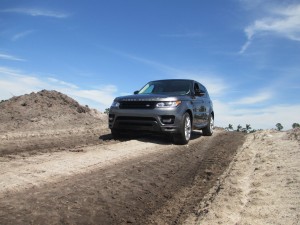 Terrain Response® 2 features an Auto setting that uses sophisticated systems to analyze the current driving conditions, and automatically select the most suitable terrain program. Ensuring that the vehicle is always driving in the optimum mode, the new system is able to switch automatically between the five settings: General, Grass/Gravel/Snow, Mud/Ruts, Sand and Rock Crawl3.
Terrain Response® 2 features an Auto setting that uses sophisticated systems to analyze the current driving conditions, and automatically select the most suitable terrain program. Ensuring that the vehicle is always driving in the optimum mode, the new system is able to switch automatically between the five settings: General, Grass/Gravel/Snow, Mud/Ruts, Sand and Rock Crawl3.
As in previous Terrain Response® systems, each setting optimizes drivability and traction by adapting the responses of the engine, transmission, differentials, and chassis systems to match the demands of the terrain. While it functions automatically, Terrain Response® 2 will also provide the driver with additional advice, such as when to select low range or raise the vehicle to off-road ride height, when the system calculates that it is necessary3.
- Land Rover Terrain Response® is complemented by standard driving aids3 including:
- Dynamic Stability Control (DSC)
- Roll Stability Control (RSC)
- Electronic Traction Control (ETC)
- Trailer Stability Assist (TSA)
- Hill Descent Control (HDC®) and Gradient Release Control (GRC)
- Hill Start Assist (HSA)
- Engine Drag Torque Control (EDC)
- Anti-lock Braking System (ABS)
- Electronic Brake Force Distribution (EBD)
- Emergency Brake Lights (EBL)
- Emergency Brake Assist (EBA)
- Corner Brake Control (CBC)
Full-time intelligent 4WD systems
The new-generation Range Rover Sport offers a choice of two full-time intelligent 4WD systems, each able to deliver outstanding traction on even the most challenging low-grip surfaces.
A two-speed transfer case system is available (standard on supercharged V8 models), with a low-range for the most demanding off-road conditions, and features a 50:50 percent default front to rear torque split. Optimum traction is maintained through an electronically controlled multi-plate clutch in the center differential, which can distribute torque between the wheels at any ratio between 100 percent front and 100 percent rear. This is combined with responsive and sophisticated electronic traction control systems. The transfer case offers selectable high and low range with shift-on-the-fly capability at speeds up to 37 mph (60km/h). The 2.93:1 low range ratio yields an extremely low crawl speed.
The standard 4WD system, which is 40 lbs. lighter, features a single-speed transfer case with a Torsen® differential. Its 42:58 percent default front to rear torque split is designed to provide a rear-wheel drive bias for optimum driving dynamics, while maintaining off-road performance capability. The Torsen center differential constantly varies torque distribution between 62 percent front and 78 percent rear depending on conditions and available grip. The traction control system has been tuned to work in conjunction with the differential to deliver excellent traction in all conditions.
To maximize traction and stability in extreme conditions, a Dynamic Active Rear Locking Differential is available in combination with the dual-range 4WD transfer case. The locking rear differential has been engineered to work in conjunction with the electronic torque vectoring system3.
Engineered for all-terrain capability
The Range Rover Sport features body geometry to handle all terrain conditions, with 2.3-inches more ground clearance than the previous model at 11.2-inches (measured at off-road ride height), and generous approach and departure angles. The underfloor provides a smooth surface, with a smooth transition between suspension components, to reduce vulnerability to damage or interference. Wading depth of 33.5-inches for all models is an increase of nearly 6-inches over the previous-generation Range Rover Sport, thanks mainly to an air intake system that draws air from stacks extending into the hood3.
The re-engineered air suspension system with its +1.4-inch (35mm) intermediate setting means that the off-road mode can be used at much higher speeds than before (50 mph / 80km/h vs 31 mph / 50km/h), which is especially useful in terrain with long, rutted dirt roads.
The air suspension offers outstanding wheel articulation, and this is further enhanced when the Dynamic Response active lean control system is fitted. If this system detects off-road conditions, it isolates the stabilizer bar and reduces the level of roll compensation, thus allowing greater wheel articulation and increasing the tire contact patch with the terrain. Dynamic Response equipped vehicles benefit from 21.5 -inches (546mm) of wheel articulation.
Land Rover toughness and durability
In developing the aluminum-intensive body structure advanced computer simulations were used to analyze the punishing off-road loads that push a vehicle’s structure to its limits. One such example is the brutal ‘ditch drop’ impact. Well over 20,000 physical tests were completed across all components and systems, with a fleet of development vehicles covering countless thousands of miles over 18 months of arduous testing in more than 20 countries with extremes of climate and road surfaces.
Prototypes were driven in challenging off-road conditions such as sand, mud and snow, and their durability was put to the test in extreme exercises to verify deep wading, underfloor vulnerability, snatch recovery and towing at maximum towing weight. Further extreme strength tests include worst-case scenarios, such as driving into curbs at speed, bridge jumps, ditch drops and sideways curb strikes.
Punishing longer test regimes provide the ultimate challenge for durability and reliability including the month-long ‘king of the sand’ durability test in intense Middle East desert heat, a 5,000 mile flat-out endurance drive at the Nürburgring circuit in Germany, and grueling off-road test cycles involving thousands of miles at challenging UK proving grounds.
Range Rover Sport powertrains
The Range Rover Sport features a choice between a 340hp 3-liter supercharged V6 engine, the 510hp 5-liter supercharged V8 and, exclusively for the SVR, a 550hp supercharged V8. A standard Intelligent Stop/Start system can also help reduce fuel consumption and emissions in urban driving. This system features a Tandem Solenoid Starter with a dedicated secondary battery for instant restarting.
Smart regenerative charging is an intelligent power management system that prioritizes charging when the vehicle is decelerating, capturing the wasted kinetic energy and reducing the fuel demand of the electrical system. An ECO Driving feature provides fuel consumption information via the 8-inch touchscreen, to encourage adoption of economical driving habits.
510hp Supercharged V8
The 510hp 5-liter V8 supercharged engine enables the Range Rover Sport to accelerate from 0-60 mph in 5.0 seconds2.The stunning performance is accompanied by a sporting soundtrack generated by a specially tuned exhaust system and sound symposer on the intake system.
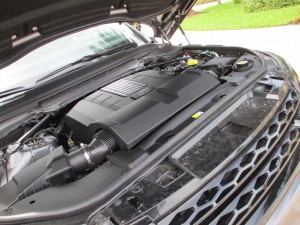 The V8 has a compact all-aluminum design, with low levels of internal friction. High-pressure direct injection uses a centrally mounted, multi-hole, spray-guided injection system. Efficiency is further enhanced by a cam torque actuated, dual independent variable camshaft timing system. A sixth-generation, twin vortex system supercharger is fitted, which offers superior thermodynamic efficiency and low noise.
The V8 has a compact all-aluminum design, with low levels of internal friction. High-pressure direct injection uses a centrally mounted, multi-hole, spray-guided injection system. Efficiency is further enhanced by a cam torque actuated, dual independent variable camshaft timing system. A sixth-generation, twin vortex system supercharger is fitted, which offers superior thermodynamic efficiency and low noise.
3-liter Supercharged V6
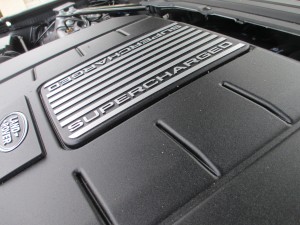 The 340hp 3-liter V6 engine delivers generous torque throughout the engine speed range, delivering confident performance with outstanding refinement. As a 90-degree engine based on the Land Rover 5-liter V8, the V6 features an innovative balance weight system to ensure exceptionally smooth and refined performance. The 340hp supercharged V6 Range Rover Sport achieves the 0-60 mph dash in 6.9 seconds2. Enthusiastic drivers will also be pleased with a sporting engine note, which is emphasized by a sound symposer on the intake system.
The 340hp 3-liter V6 engine delivers generous torque throughout the engine speed range, delivering confident performance with outstanding refinement. As a 90-degree engine based on the Land Rover 5-liter V8, the V6 features an innovative balance weight system to ensure exceptionally smooth and refined performance. The 340hp supercharged V6 Range Rover Sport achieves the 0-60 mph dash in 6.9 seconds2. Enthusiastic drivers will also be pleased with a sporting engine note, which is emphasized by a sound symposer on the intake system.
Advanced 8-speed automatic transmission
All Range Rover Sport engines are paired with the advanced electronically controlled 8-speed automatic transmission, tuned by Land Rover engineers to combine silky-smooth shifting with exceptionally rapid responses. With eight closely spaced ratios, gear changes are almost imperceptible, with each shift completed in just 200 milliseconds (50 percent quicker in the SVR).
Controls include the sporting vertical gear shifter, plus the option of steering wheel-mounted paddle-shifters. Either system enables the driver to take control of gear shifting manually. The transmission will also accept multiple downshifts, maintaining a smooth transition between ratios. The transmission is tuned to select torque converter lock-up as early as possible to reduce slip and energy loss. Transmission Idle Control disengages 70 percent of the drive torque when the vehicle is stationary and the engine is idling in Drive, helping to reduce fuel consumption.
Enhanced efficiency drives improved sustainability
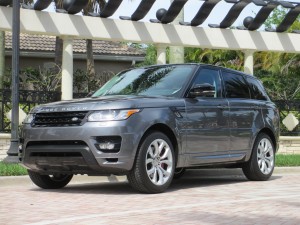 The Range Rover Sport demonstrates the commitment of Land Rover in enhancing the sustainability of its products and operations. The Range Rover Sport takes a comprehensive approach to reducing environmental impact throughout the life-cycle of the vehicle, from development and manufacturing, to customer use and end-of-life.
The Range Rover Sport demonstrates the commitment of Land Rover in enhancing the sustainability of its products and operations. The Range Rover Sport takes a comprehensive approach to reducing environmental impact throughout the life-cycle of the vehicle, from development and manufacturing, to customer use and end-of-life.
High-strength aluminum construction
The next-generation aluminum platform design continues our expertise in aerospace-inspired, high-performance aluminum structures, having pioneered this technology in mass production in 2003. The structure is impressively light and extremely strong. The joints in the shell are riveted and bonded together using aerospace techniques adapted for automotive use. Traditional energy intensive construction methods, such as spot welding, are not required.
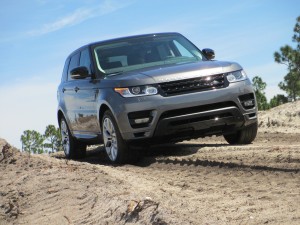 Critical to engineering such a weight-efficient body is the way different forms of aluminum components are employed within the structure: press formed panels, plus cast, extruded and rolled aluminum alloy parts, are combined in a structure where the strength is concentrated precisely where the loads are greatest. The resulting structure protects occupants using a strong and stable safety cell, and provides a very stiff platform for superior NVH and vehicle dynamics.
Critical to engineering such a weight-efficient body is the way different forms of aluminum components are employed within the structure: press formed panels, plus cast, extruded and rolled aluminum alloy parts, are combined in a structure where the strength is concentrated precisely where the loads are greatest. The resulting structure protects occupants using a strong and stable safety cell, and provides a very stiff platform for superior NVH and vehicle dynamics.
Innovations to further reduce weight and enhance performance include the first automotive use of high strength AC300 aluminum within the crash structure. In another automotive first, the entire vehicle body sides are formed as single aluminum panels – reducing the number of joints, eliminating complex assemblies and improving structural integrity.
- Key weight-saving technologies in the vehicle include:
- All-aluminum door construction, including high-strength aluminum side intrusion beams
- Front and rear suspension design with aluminum front and rear subframes
- Aluminum final drive units and driveline components
- High precision magnesium castings used for the cross car beam and front end carrier
- SMC (Sheet Molded Composite) tailgate
- High-strength steel seat structures
Streamlined aerodynamics
- Aerodynamic underfloor paneling – extensive paneling creates a smooth, flat profile under the vehicle. Additional deflectors have been added around the front and rear suspension components, with front and rear undertrays around the main driveline components.
- Enhanced air flow – detail features to improve air flow include near-flush glazing on the
A-pillars and vehicle side glass; separation edges incorporated in the rear lamps and D-pillars; optimized shaping of the door mirrors and upper rear spoiler.
Special attention has also been given to water management on the vehicle, including a hydrophobic coating on the front side door glass to help keep it clear of droplets, roof panels shaped to avoid unwanted drips when the tailgate is opened and a rear washer/wiper designed to avoid annoying drips.
Smart driver assistance technologies
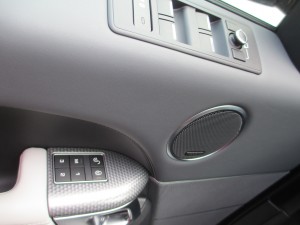 The Range Rover Sport is packed with smart, relevant technologies to ensure that drivers enjoy a relaxed and stress-free experience.
The Range Rover Sport is packed with smart, relevant technologies to ensure that drivers enjoy a relaxed and stress-free experience.
An innovative digital camera system supports three driver assistance features that help deliver improved driver awareness3. Mounted next to the rear view mirror, the forward facing camera captures a view of the road ahead, which is analyzed by an on-board computer.
Lane Departure Warning3
This system is designed to warn the driver via a vibration in the steering wheel if an unintentional drift out of the lane begins. If the vehicle drifts from the center of the lane, and the system does not detect an obvious lane-change maneuver or use of the signals, the vibration alert is triggered. This is reinforced by an alert in the instrument cluster. The system operates above 37 mph (60 km/h), so it does not interfere in urban conditions. The driver can adjust the system’s sensitivity (two levels) and the alert intensity (three levels), or can turn the system off.
Traffic Sign Recognition3
This system uses the camera to identify traffic signs on either side of the road and on bridges, providing the driver with information about the latest detected speed limit, road closure signs and passing regulations via the instrument cluster display. To indicate how recent the information is, the displayed sign fades away in a series of steps as the distance increases from the sign. The driver can configure the system to flash the speed limit sign in the display when the vehicle exceeds a limit that he or she sets.
Automatic High Beam Assist3
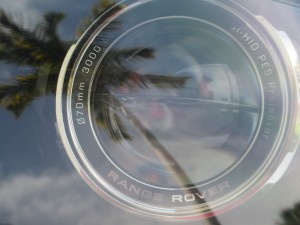 This system switches the headlamps automatically between high and low beam in response to other vehicles and ambient light levels.
This system switches the headlamps automatically between high and low beam in response to other vehicles and ambient light levels.
Flank Guard (360 degree Park Distance Control)3
Flank Guard helps alert the driver to potential side impacts, and scrapes on the sides of the vehicle during tight maneuvers such as in parking garages. The feature is enabled by the addition of extra distance sensors on the vehicle (now 6 sensors front and rear, instead of 4), which provide wider coverage around the vehicle than conventional park distance sensors. The driver is warned of potential impacts by audible beeps, while the central instrument cluster display uses distance bars to indicate the proximity of objects. Using information on the vehicle’s steering angle and trajectory, the system only warns when there is a threat of impact, and can ignore close objects if the vehicle is steering away from them.
Additional driver assistance features available include an enhanced Adaptive Cruise Control (ACC)which maintains a pre-set time gap to the vehicle in front3. Adding to the standard ACC functionality, the Queue Assist feature allows the vehicle to come to a stop when it reaches a traffic stoppage. When the vehicle in front moves off, the driver can resume ACC operation by briefly touching the accelerator3. The Range Rover Sport then accelerates back to the pre-set cruising speed, maintaining the selected time gap to vehicles ahead.
For enhanced awareness in congested traffic conditions, Range Rover Sport drivers can also specify advanced new technologies to alert them to nearby vehicles that could create a hazard.
Blind Spot Monitoring3
Side-mounted radar sensors survey potential blind spots on either side of the vehicle and alert the driver when vehicles are detected within this area. The system is engineered to work at speeds commonly encountered in urban conditions or on congested highways. It is combined with Closing Vehicle Sensing, which scans a zone much further behind the vehicle to detect vehicles which are closing quickly and which could cause a threat during a lane change maneuver3. Drivers are alerted by a rapid flashing of the Blind Spot warning light in the corresponding exterior mirror.
Reverse Traffic Detection uses radar detectors in the rear of the vehicle to warn about potential collisions during reversing maneuvers3. The system is active when reverse gear is selected and can detect a vehicle approaching from either side, alerting the driver to a potential collision.
Adjustable Speed Limiter Device enables the driver to set a personal maximum speed limiting governor3. This can be quickly deactivated.
Surround Camera Systemincorporating “T-Junction” (intersection) view, trailer reverse park guidance and trailer hitch guidance3.
Adaptive Xenon headlamps turn in the direction of steering travel3.
Electric Power-Assisted Steering with advanced Park Assist functions3
The electric power-assisted steering enables advanced Park Assist features, including:
- Park Assist helps to identify a suitable parallel parking space and then automatically steers the vehicle into place; the driver controls gearshift selection, throttle, and brake application.
- Park Exit helps drivers exit tight parallel parking spaces, by automatically steering the vehicle back onto the road.
- Perpendicular Park extends the function of the system to help the driver to reverse into perpendicular spaces, using sensors to help identify a suitable space where the vehicle can be parked and the doors on each side opened safely.
- 360-degree Park Distance Control will provide virtual object tracking along the sides of the vehicle at speeds of up to 10 mph (16km/h).
Each of the functions provides the driver with clear instructions via the instrument cluster display, and uses the Park Distance Controls, and camera systems (where fitted) to help warn the driver of objects in close proximity during the maneuver. (Multiple shuttles back and forward may be required to complete the maneuvers safely and accurately.)
Powerful braking and enhanced active safety technologies
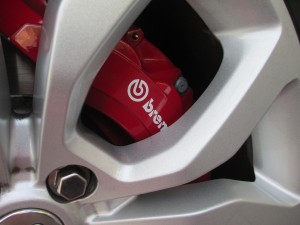 On the supercharged V8, the powerful braking system features six-piston lightweight Brembo front calipers for enhanced performance. Generous disc diameters of 14.96-inches (380mm) front /14.32-inches (365mm) rear or 13.8-inches (350mm) front / 13.8-inches (350mm) rear on V6 models and those fitted with 19-inch wheels, provide substantial thermal capacity for excellent stopping performance.
On the supercharged V8, the powerful braking system features six-piston lightweight Brembo front calipers for enhanced performance. Generous disc diameters of 14.96-inches (380mm) front /14.32-inches (365mm) rear or 13.8-inches (350mm) front / 13.8-inches (350mm) rear on V6 models and those fitted with 19-inch wheels, provide substantial thermal capacity for excellent stopping performance.
Safety engineering
Designed to minimize peak impact forces and intrusion into the safety cell, while delivering maximum occupant protection, the aluminum body structure includes key features such as the use of high strength AC300 aluminum within the crash structure and a composite reinforced B-post area to maximize side impact protection.
The occupant safety package includes driver and passenger airbags, side curtain and thorax airbags (including an extended curtain airbag which covers passengers occupying the third row seats), and active front seat belts linked to the vehicle’s emergency braking functions6.
Pedestrian safety has been addressed with an optimized design for the front-end, bumpers, hood and cowl area to help minimize potential injuries. Key measures include a raised hood A-surface, hood and bumper profiles designed for energy absorption, along with the optimization of the coupling of surface parts with under-body structures to maximize energy absorption.
REFINEMENT AND VERSATILITY
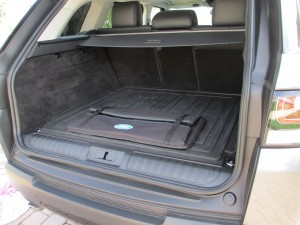 Befitting the brand, the Range Rover Sport model’s agile handling is accompanied by exceptional refinement and comfort. The vehicle’s appeal is extended further by versatility, with a spacious and flexible interior that offers the option of occasional-use 5+2 seating, and the capability to tow a 7,716 pound (3,500kg) trailer.
Befitting the brand, the Range Rover Sport model’s agile handling is accompanied by exceptional refinement and comfort. The vehicle’s appeal is extended further by versatility, with a spacious and flexible interior that offers the option of occasional-use 5+2 seating, and the capability to tow a 7,716 pound (3,500kg) trailer.
Supple ride quality
With its long wheel travel and upgraded four-corner air suspension, the Range Rover Sport combines outstanding poise and stability with excellent ride isolation on all surfaces. Finely calibrated damping ensures that the vehicle delivers a supple and absorbent ride, along with excellent composure and body control.
Hushed cabin for all-day comfort
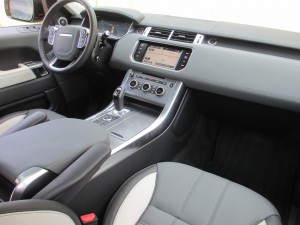 Unwanted sounds and traces of harshness were eliminated through the use of advanced computer simulations in the engineering phase, followed by painstaking optimization with test cells using sophisticated analysis tools such as specialized acoustic cameras.
Unwanted sounds and traces of harshness were eliminated through the use of advanced computer simulations in the engineering phase, followed by painstaking optimization with test cells using sophisticated analysis tools such as specialized acoustic cameras.
Extremely stiff chassis attachment points help to minimize the transmission of noise and vibrations, while the use of stiff alloy suspension components, along with specially developed bushings, help to eliminate road noise. Acoustic lamination applied to the windshield glass helps to further reduce powertrain noise as well as wind noise, which has been minimized through analysis with computational fluid dynamics and exhaustive wind tunnel tests. All operating sounds within the Range Rover Sport, from door closing sounds to the noises made by switches and motors, were rigorously analyzed and refined to create premium sound quality.
Premium interior features, with exclusive audio and seamless connectivity
Exclusive audio systems have been developed with Meridian™, a world leader in audio technologies and digital sound processing. Three branded Meridian™ audio systems are available, ranging up to the stunning 1700W** Signature Reference system which has 23 speakers including a subwoofer to offer the ultimate surround sound experience (** Power ratings are at a practically audio distortion free level of 0.2% THD + N [Total Harmonic Distortion plus Noise]).
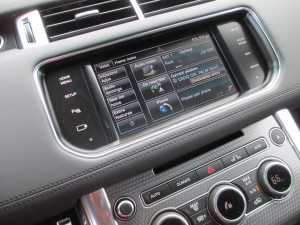 The three systems feature amplifiers that incorporate the latest Meridian™ digital processing technology, along with high-efficiency speakers for exceptional clarity and acoustics. In addition, the Audyssey MultEQ XT audio tuning system which digitally corrects any imperfections created by the cabin environment to deliver accurate, enveloping, and distortion-free sound throughout the vehicle.
The three systems feature amplifiers that incorporate the latest Meridian™ digital processing technology, along with high-efficiency speakers for exceptional clarity and acoustics. In addition, the Audyssey MultEQ XT audio tuning system which digitally corrects any imperfections created by the cabin environment to deliver accurate, enveloping, and distortion-free sound throughout the vehicle.
The connectivity package1 includes:
- Hands-free mobile phone via Bluetooth®, enabling the phone to be controlled via the 8-inch touchscreen or steering wheel controls
- Bluetooth audio streaming, to play music stored on a phone, or other portable Bluetooth device, via the car’s audio system
- Voice control, with intuitive ‘Say What You See’ display prompts
- USB connectivity for iPod®/MP3 players or memory sticks
Land Rover InControl® Apps
Land Rover InControl Apps, developed in conjunction with BOSCH SoftTec, offer a wide range of connectivity functions and are compatible with the latest Apple® and Android™ smartphones1. By connecting a smartphone to the dedicated USB port, smartphone apps optimized for in-vehicle use will function on the vehicle’s touchscreen, retaining their original look and feel3. The latest content becomes available every time the apps update.
A productivity suite enables easy access to the connected smartphone’s contacts, calendar and music library, while a Maps app includes maps and satellite views overlaid with the vehicle location.
Land Rover and BOSCH SoftTec worked together with some of the world’s leading smartphone app developers to create apps ideally suited for in-car use, such as navigation, music streaming, Internet radio and location services. Compatible apps include iHeartRadio, Stitcher, Glympse, Sygic, Parkopedia, Hotelseeker, Cityseeker, Eventseeker, Airmotion News, Winston and MobileDay. The selection is being continually expanded.
Owners download the Land Rover InControl Apps application to their smartphones from either the Apple App Store™ (for iPhone 5/5S/5C and up) or Google Play™ (Android). Once the phone is connected to the vehicle’s dedicated USB port, the owner simply taps the InControl Apps™ icon on the central touchscreen and selects the desired app from the menu1.
InControl Remote and Protect™
InControl Remote and Protect™ allows owners to request roadside assistance or emergency services, while an SOS signal is triggered automatically should the airbags be deployed in an accident. The InControl Remote and Protect™ smartphone application allows owners to prepare for a trip by checking fuel levels and range remotely, find their vehicle in a crowded parking lot, and check if doors or windows were left open. Owners can also download trip details to assist in tracking business mileage expenses.
Climate control proven in extreme conditions
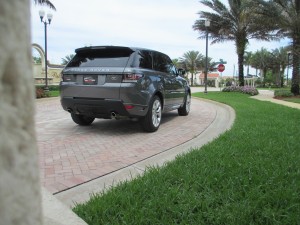 The automatic climate control system was tested in punishing real-world conditions in temperatures ranging from +122 to -22 deg. F. Two versions are available: A standard two-zone system provides individual controls for the driver and front passenger. An optional premium four-zone system incorporates an additional climate control unit in the rear compartment and separate controls for driver, front passenger and each side of the rear cabin.
The automatic climate control system was tested in punishing real-world conditions in temperatures ranging from +122 to -22 deg. F. Two versions are available: A standard two-zone system provides individual controls for the driver and front passenger. An optional premium four-zone system incorporates an additional climate control unit in the rear compartment and separate controls for driver, front passenger and each side of the rear cabin.
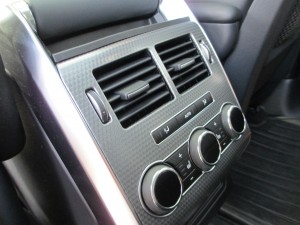 Employing discharge air temperature sensors on all outlets, along with solar sensors in front and rear compartments, the climate control system can respond quickly and accurately. With its independent heating and cooling capability in the rear compartment, the four-zone system offers exceptional rear seat comfort, with multiple outlets at upper and lower levels.
Employing discharge air temperature sensors on all outlets, along with solar sensors in front and rear compartments, the climate control system can respond quickly and accurately. With its independent heating and cooling capability in the rear compartment, the four-zone system offers exceptional rear seat comfort, with multiple outlets at upper and lower levels.
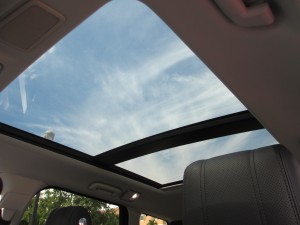 The Range Rover Sport offers a full-size sliding panoramic glass roof, with no unsightly supporting structure visible to provide an uninterrupted vista and enhanced headroom. An electric fabric sun blind with a solar reflective coating can be extended across the full surface of the glass. An alternative fixed glass panoramic roof is also available.
The Range Rover Sport offers a full-size sliding panoramic glass roof, with no unsightly supporting structure visible to provide an uninterrupted vista and enhanced headroom. An electric fabric sun blind with a solar reflective coating can be extended across the full surface of the glass. An alternative fixed glass panoramic roof is also available.
Comfort and convenience in every detail
Each aspect of the new Range Rover Sport has been meticulously refined with premium luxury in mind. Premium features include:
- Enhanced seating – high series models offer 14-way power adjustable front seats with new features including climate control, adjustable bolsters and winged headrests. Rear seats offer adjustable recline and climate control, with a 60/40 split, while the versatility of occasional 5+2 third-row seating is an option.
- Premium infotainment – Rear Seat Entertainment (RSE) package with twin video screens and a dedicated remote control and WhiteFire™ infrared wireless digital headphones.
- Customer configurable mood lighting – sophisticated LED ambient lighting with variable colors that can be adjusted by the customer.
- Powered tailgate – power open/close operation using the remote control key fob, buttons on the tailgate, or from the driver’s seat.
- Keyless entry and start system – Smart Key system enabling keyless entry and start.
- Power operated child locks – power operated child locks on the rear doors are fitted as standard.
- Center Console Cooler – a cooler compartment in the front center console armrest is available as an option.
- Heated front windshield/seats/steering wheel -for cold-weather comfort.
5+2 third row seating
The rear seats recline and offer 60/40 folding capability for up to 62.2 cubic feet (1,761 liters) of load space. The second row seats also provide 3.8-inches (100mm) fore/aft movement to allow customers a flexible choice of space in the rear seat rows and in the luggage compartment.
For additional versatility, neatly integrated third row seats can be optioned, and provide “5+2” third row seats designed for occasional use. These seats split 50/50 and are designed to be suitable for children and teenagers but may also be used for adults on short trips. Using a convenient lever on the backrest with one-hand operation, the second row seats tip and slide forward to provide access to the third row. The third row seats include power operation, and can be raised/lowered electrically using controls mounted on either side of the cabin and within the luggage area. When folded, the third row seats leave a flat floor, with no loss of capacity in the luggage compartment when compared to the 5-seat model.
Interior storage space includes a large glove box, generous door bins, twin 44-oz. cupholders in the center console, large central armrest stowage, plus improved cup holders in the rear armrests.
Towing capability and lifestyle accessories extend versatility
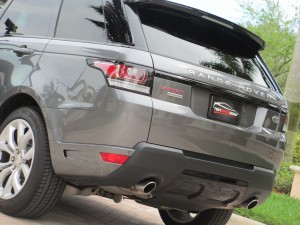 The Range Rover Sport can tow up to 7,716lbs. (3,500kg). Key additional features to enhance towing include the Trailer Stability Assist system and Surround Camera system with Tow Assist for easier hitching and reversing3.
The Range Rover Sport can tow up to 7,716lbs. (3,500kg). Key additional features to enhance towing include the Trailer Stability Assist system and Surround Camera system with Tow Assist for easier hitching and reversing3.
Power-deployable side steps are available for the first time on Range Rover Sport. The full range of lifestyle accessories provides a wide selection of functional items including: roof rails and cross bars complemented by an extensive roof carrying range, exterior features including side protection tubes, side steps and stainless steel undershields, interior load carrying aids including loadspace liners, luggage guards and a rail system, and a new lockable security box.
Sustainable by design, with a full lifecycle approach
The Range Rover Sport has been designed with a full lifecycle approach, aiming to minimize the environmental impact by considering the entire lifecycle of the vehicle: from development and manufacturing, through customer use, to end-of-life recycling and re-use. Each element of the lifecycle was analyzed with a view to consuming fewer natural resources, using more sustainable materials and minimizing the generation of waste. The development process included a full lifecycle assessment in line with ISO 14040/14044.
The aluminum construction makes a major contribution to the model’s reduced carbon footprint.
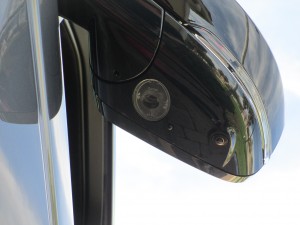 Up to 75-percent of the aluminum material is sourced from reclaimed content, including closed loop recycling of waste metal from the manufacturing process, resulting in a significant saving of energy and emissions (body panels made from recycled material use only 5-percent of the energy required for new aluminum). Further energy is saved during the manufacturing process, which does not require highly energy intensive processes like welding.
Up to 75-percent of the aluminum material is sourced from reclaimed content, including closed loop recycling of waste metal from the manufacturing process, resulting in a significant saving of energy and emissions (body panels made from recycled material use only 5-percent of the energy required for new aluminum). Further energy is saved during the manufacturing process, which does not require highly energy intensive processes like welding.
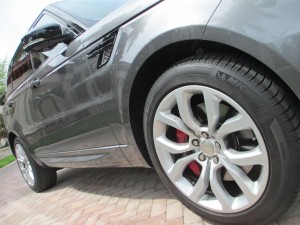 Recycled and renewable materials have been used wherever possible. High specification vehicles use up to 59lbs. (26.7kg) of recycled plastics, diverting thousands of tons of plastic from landfills during the carline’s life. Natural and renewable materials, such as the luxurious leathers and veneers, represent nearly 62lbs. (28kg) in each vehicle.
Recycled and renewable materials have been used wherever possible. High specification vehicles use up to 59lbs. (26.7kg) of recycled plastics, diverting thousands of tons of plastic from landfills during the carline’s life. Natural and renewable materials, such as the luxurious leathers and veneers, represent nearly 62lbs. (28kg) in each vehicle.
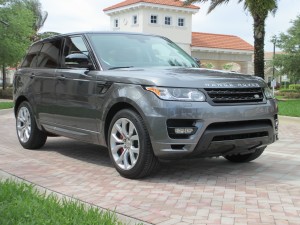 2015 RANGE ROVER SPORT V8 AUTOBIOGRAPHY QUICK TAKES MSRP $79,995
2015 RANGE ROVER SPORT V8 AUTOBIOGRAPHY QUICK TAKES MSRP $79,995
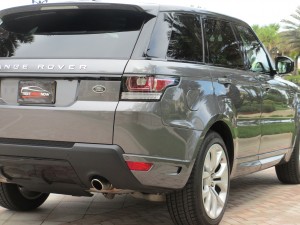 AS SHOWN WITH AUTOBIOGRAPHY PACKAGE, MERIDIAN SIGNATURE AUDIO, ETC $ 98,107.00
AS SHOWN WITH AUTOBIOGRAPHY PACKAGE, MERIDIAN SIGNATURE AUDIO, ETC $ 98,107.00
 CLICK HERE TO FIND TODAY’S HOTTEST DEALS FOR ALL YOUR AUTOMOTIVE NEEDS.
CLICK HERE TO FIND TODAY’S HOTTEST DEALS FOR ALL YOUR AUTOMOTIVE NEEDS.
 CLICK HERE to LIKE TestDriveNow.com on FaceBook!
CLICK HERE to LIKE TestDriveNow.com on FaceBook!
 FOLLOW Steve Hammes on Twitter @DriveTimeVideos!
FOLLOW Steve Hammes on Twitter @DriveTimeVideos!
*Lightest ‘weight from’ figure on previous Range Rover Sport 2535kg; lightest ‘weight from’ figure on current Range Rover Sport is 2022kg.
1 Driving while distracted can result in loss of vehicle control. Do not operate, adjust or view the navigation or multimedia systems under conditions that will affect your safety or the safety of others. Only use mobile phones and other devices, even with voice commands, when it is safe to do so.
2 Always follow local speed limits.
3These systems are not a substitute for driving safely with due care and attention and will not function under all circumstances, speeds, weather and road conditions, etc. Driver should not assume that these systems will correct errors of judgment in driving. Please consult the owner’s manual or your local authorized Land Rover Retailer for more details.
4 Price shown is MSRP. Excludes $925 destination and handling charge, tax, title, license, retailer fees and optional equipment. Retailer price, terms and vehicles availability may vary. See your local authorized Land RoverRetailer for details.
5 EPA estimates. Actual mileage may vary.
6 Please remember that the safety belts in a vehicle constitute the primary protection system for driver and passengers in collisions. Airbags are not designed to deploy in all collisions. The airbag Supplemental Restraint System (SRS) is a supplement to the safety belts and is designed to work as a system with the safety belts. Although airbags provide additional protection, airbags without safety belts do not provide optimal protection in a crash. Always wear your safety belts. Children younger than 13 years old should always be properly restrained in a back seat, away from airbags. Never place an infant seat in the front seat.

 CLICK HERE to get a FREE ONLINE PRICE QUOTE for your next NEW CAR from a dealer near you. Absolutely NO OBLIGATION.
CLICK HERE to get a FREE ONLINE PRICE QUOTE for your next NEW CAR from a dealer near you. Absolutely NO OBLIGATION.  CLICK HERE TO FIND THE BEST DEAL ON TIRES FOR EVERY MAKE AND MODEL CAR, TRUCK OR SUV. SPECIAL DISCOUNTS FOR TESTDRIVENOW FANS.
CLICK HERE TO FIND THE BEST DEAL ON TIRES FOR EVERY MAKE AND MODEL CAR, TRUCK OR SUV. SPECIAL DISCOUNTS FOR TESTDRIVENOW FANS.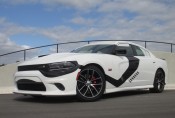 2015 DODGE CHARGER RT SCAT PACK
2015 DODGE CHARGER RT SCAT PACK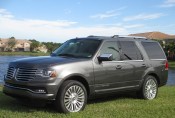 2015 LINCOLN NAVIGATOR QUICK TAKES
2015 LINCOLN NAVIGATOR QUICK TAKES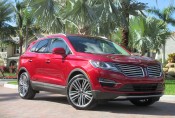 2015 LINCOLN MKC AWD QUICK TAKES
2015 LINCOLN MKC AWD QUICK TAKES